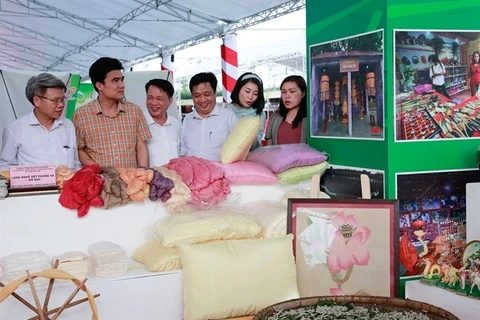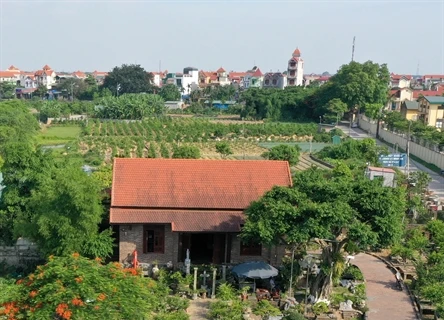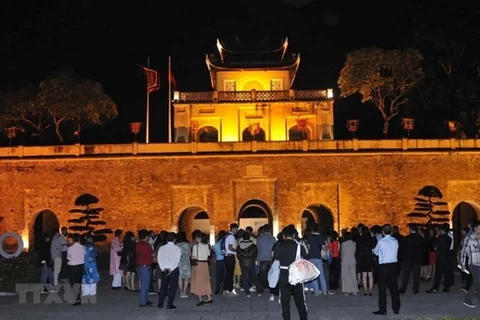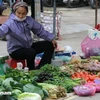Hanoi (VNA) – Despite facing difficulties due to the COVID-19 pandemic, craft villages in Hanoi have managed to balance between maintaining production and preservation of traditional values.
With 1,350 craft villages, Hanoi boasts the most traditional craft villages and most talented artisans in Vietnam.
Ha Thai lacquer village in Duyen Thai commune in Hanoi’s outlying district of Thuong Tin is a typical example.
It has more than 300 households engaged in the craft with over 1,500 labourers.
Lacquer products of Ha Thai village have been known for their high quality and durable thanks to the skilful and creativeness of craftsmen.
They do not only have a foothold in the domestic market but also export to the world markets such as France, the United States and Spain, accounting for 60 percent of the total products of the village.
Do Trong Doan, a local artisan, said they encountered many difficulties due to bad sales of lacquer products.
He attributed it to the fact that the quality of human resources was not high.
The low competitiveness in the international market and unstable of material supply were also problems. However, local households have still strived to overcome challenges, seeking relevant sales model and maintain production in this difficult condition.
A similar situation was also reported in other traditional craft villages.
Pham Khac Ha, Chairman of the Van Phuc Silk Weaving Village Association in Ha Dong district said, given the complicated developments of COVID-19, pandemic prevention and control along with resuming production and trade are big challenges for craft villages.
Some businesses and production facilities have started selling their products on social networks and obtaining encouraging results, he said.
Many establishments have also taken part in domestic exhibitions and fairs to exploit the consumption market and capture the tastes of customers.
Attention has been paid to creating patterns and types of products to make them more attractive, Ha said.
Realising the shortcomings of craft villages, the Hanoi Handicraft and Craft village Association has supported its members participating in the programme to consult and design new handicraft products to develop the domestic market and for export.
Vocational and business administration training programme related to craft villages were also offered to the members to help them have more skills and ideas to produce new products which meet the market demand. Thus, they can improve their knowledge of corporate governance, research and apply new technology to save input costs and raise the competitiveness and value for the products.
Preservation of traditional values
Craft villages in Hanoi haven't only overcome difficulty to develop production but also concentrated on promoting their traditional values.
Hoang Quoc Chinh, Chairman of the Da Sy Craft Village Association in Ha Dong district, said he was so proud of a long history of blacksmithing in the village.
The forging of tools have been happening in Da Sy village since the end of the 16th century.
Experiencing many ups and downs of the trade and associating with the struggle for national liberation, Da Sy forging village is constantly developing and playing an important role in locals’ life.
Furthermore, the village has become a national relic. During a visit to Da Sy village, tourists do not only to learn about traditional craft, but also make their own products. Therefore, Ha Dong authorities have created favourable conditions for its production and business activities in order to preserve and bring into play the traditional craft in the 2020-2025 period.
In Van Phuc silk village, local authorities have encouraged artisans to align with tourist companies to bring visitors back to the craft village.
Ha Thi Vinh, chairwoman of the Hanoi Handicraft and Craft Village Association, suggested that Hanoi authorities facilitate the sustainable development of craft villages by creating favourable conditions for the young generation to attach long-term commitment to the profession and preserving cultural identity in their own homeland.
Schools and vocational training centres should be encouraged to compile separate textbooks for students on product design and professional skills for each type of products.
It is necessary for the city to launch a movement to motivate young people to join vocational training for the development of local profession, Vinh said, adding that it is one of the effective solutions to preserve traditional craft./.

Hanoi boosts sale of rural products
With many craft villages and a huge amount of products qualified for the One Commune One Product (OCOP) programme, Hanoi has many strengths in rural economic development.























